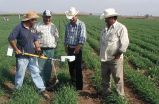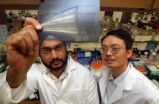(Press-News.org) New technologies can improve agricultural sustainability in developing countries, but only with the engagement of local farmers and the social and economic networks they depend on, say Stanford University researchers. Their findings are published in the May 23 online edition of the Proceedings of the National Academy of Sciences (PNAS).
"Most people tend to think that technology information flows to farmers through a direct pipeline from scientists, but that isn't true," said lead author Ellen McCullough, a former research fellow at Stanford's Program on Food Security and the Environment, now at the Bill and Melinda Gates Foundation.
The study was co-authored by Pamela Matson, dean of the School of Earth Sciences and senior fellow at the Woods Institute for the Environment at Stanford.
To better understand how farmers decide to adopt new technologies, the researchers interviewed growers, farm credit unions and agricultural experts in the Yaqui Valley in Sonora, Mexico – the birthplace of the "green revolution" in wheat and one of Mexico's most productive breadbaskets.
Matson and other Stanford researchers have been working in the Yaqui Valley for nearly 20 years. Among their objectives is demonstrating how science can inform agricultural policy in an area grappling with the kinds of environmental challenges that plague other intensive farming regions.
While Yaqui Valley supplies most of Mexico's wheat, the environmental costs are high, according to the Stanford researchers. Valley farms pollute local drinking water, wreck coastal ecosystems and foul the air with particulates that cause a variety of diseases.
"If scientists want to offer solutions to manage these environmental impacts, they need to understand what influences farmers' decisions about technology and production strategies," McCullough said.
Credit union clout
In Yaqui Valley, credit unions hold sway among the majority of farmers, McCullough said. In addition to providing loans, crop insurance, fertilizer and seed, credit unions have taken over the government's role in providing technical expertise and management advice.
Valley growers also have a long history of working with the Mexico-based International Maize and Wheat Improvement Center, a world-renowned agricultural research center known by its Spanish acronym, CIMMYT.
But interviews conducted for the PNAS study revealed that most farmers take their cues from local credit unions and not from experts at CIMMYT. As an example, McCullough pointed to a collaborative effort between CIMMYT scientists and farmers to develop a nitrogen diagnostic tool that reduces fertilizer use without sacrificing crop yields.
The device, which gives real-time readings of nitrogen levels in the soil, proved early on that it could save farmers 12 to 17 percent of their profits. Yet most farmers rejected the new technology until CIMMYT researchers finally convinced credit union officials that it was a worthwhile investment.
"The most successful innovations that have been adopted by farmers in the Yaqui Valley have come from collaborations among researchers, farmers and local establishments, like the credit unions," McCullough said. Because of their considerable influence among farmers, credit unions should be included in any effort to effect environmental change in the region, she added.
"The Yaqui case negates the simplistic view of the one-way flow of scientific information from the agricultural research community to the user community," Matson said. "If researchers seek to produce relevant knowledge that ultimately influences decision making, they must recognize the dynamics of the local knowledge system and participate purposefully and strategically in it."
INFORMATION:
The research was supported with grants from the National Oceanic and Atmospheric Administration and the David and Lucile Packard Foundation.
The Program on Food Security and the Environment is jointly run by the Woods Institute for the Environment and the Freeman Spogli Institute for International Studies at Stanford.
This article was written by Donna Hesterman, a science-writer intern at the Woods Institute for the Environment.
Farmer networks hold key to agricultural innovation in developing countries, Stanford study finds
2011-06-03
ELSE PRESS RELEASES FROM THIS DATE:
Cause and potential treatment found for cancer drug's kidney toxicity
2011-06-03
AUGUSTA, Ga. – Scientists may have a way to make the powerful cancer drug cisplatin less toxic to the kidneys and more effective against some cancers.
The chemotherapeutic agent used in combination with other drugs for a variety of cancers, results in kidney damage or failure in about 30 percent of users, although the mechanism has been unclear. The most physicians can do today to protect the kidneys is advise patients to drink more water.
The relatively simple, highly reactive compound tends to accumulate in the kidneys, said Dr. Navjotsingh Pabla, postdoctoral fellow ...
Iron key to brain tumor drug delivery
2011-06-03
Brain cancer therapy may be more effective if the expression of an iron-storing protein is decreased to enhance the action of therapeutic drugs on brain cancer cells, according to Penn State College of Medicine researchers.
Malignant glioblastoma multiforme is a deadly brain tumor for which no long-term effective cure exists. Because drugs in the blood do not pass from the blood vessels to the brain, effective amounts of chemotherapy drugs do not reach the tumor. Increasing dosages damage normal brain tissue and cause significant neurological damage. These dosages also ...
Children eat more vegetables when allowed to choose
2011-06-03
This release is available in French and Spanish.
A gesture as simple as allowing children to freely choose the vegetables they want to eat helps to increase the consumption of these foods in children, as University of Granada has found. Moreover, his work suggests that the bitter taste of calcium, present in vegetables such as spinach, collard greens, cabbage, onions, chard or broccoli, can be a factor negatively influencing children's consumption of vegetables.
To carry out this experimental study, the authors analyzed the main factors determining vegetable consumption ...
Building a better dam map
2011-06-03
Humans have been building reservoirs and dams for thousands of years. Over the past few decades, their construction has spiked as our need to harness water – critical in flood control, irrigation, recreation, navigation and the creation of hydroelectric power – has grown. And while dams and reservoirs have important benefits, they can also be disruptive and costly to both humans and the environment.
A close assessment of critical environmental and social tradeoffs associated with dams and reservoirs within the global river network has been impossible because the data ...
New type of MRSA in hospitalized patients probably of animal origin
2011-06-03
WASHINGTON, DC -- June 2, 2011 -- A distinctly new type of methicillin resistant Staphylococcus aureus (MRSA) that is not detected by traditional genetic screening methods has been discovered in patients in Irish hospitals according to research to be published in the journal Antimicrobial Agents and Chemotherapy. These findings provide significant insights into how new MRSA strains emerge and highlight the potential for the transmission of infectious agents from animals to humans.
MRSA is a significant cause of hospital- and community-acquired infection worldwide. MRSA ...
Wagner & Wagner Joins Environmental Alliance
2011-06-03
Wagner & Wagner, Attorneys at Law, is doing more to help its community by making a commitment to improve its environmental profile. By joining the B2B Green Alliance, Wagner & Wagner hopes to promote awareness of eco-friendly business practices for lawyers.
The B2B Green Alliance is part of Page 1 Green Solutions, an environmental commitment program sponsored by web marketing firm Page 1 Solutions. Page 1 Solutions strives to reduce its environmental impact not only by following eco-conscious practices in office but also by encouraging its clients to pursue ...
With feedlot manure, it pays to be precise
2011-06-03
This release is available in Spanish.
The same precision farming techniques that work with crops can work with manure management on cattle feedlots, according to U.S. Department of Agriculture (USDA) scientists.
Agricultural engineers Roger Eigenberg and Bryan Woodbury and their colleagues with USDA's Agricultural Research Service (ARS) in Clay Center, Neb., map the distribution of manure on the surface of feedlots and the flow of liquid manure in rain runoff.
This research could lead to both precision harvesting of manure and also precision application of manure ...
Pulling a fast one
2011-06-03
EVANSTON, Ill. --- Do those lightening fast disclaimers at the end of radio and television advertisements scare you away or simply seem like white noise required by regulatory agencies?
According to Northwestern University and Wake Forest University research now online in the Journal of Consumer Research, fast disclaimers can give consumers the impression that an advertiser is trying to conceal information. However, trusted brands (versus trust-unknown or not-trusted brands) are immune to the adverse effects of fast disclaimers.
"Speak slowly or carry a trusted brand," ...
Man Exonerated After 14 Years Gets No Support from Supreme Court
2011-06-03
It is not certain where John Thompson was one fateful night in December 1984, but one thing is clear: He was not robbing three children in Orleans Parish, Louisiana. Thompson's innocence did not prevent the District Attorney's Office in Orleans Parish from building a case against him for the robbery, or from failing to turn over blood evidence to the defense--a failure that would taint his ability to accurately defend himself against charges of robbery and murder.
The District Attorney's Office, headed by Harry Connick, Sr., tried and ultimately convicted Thompson of ...
Leakage of private information from popular websites is common, new study finds
2011-06-03
WORCESTER, Mass. – A study of more than 100 popular websites used by tens of millions of people has found that three quarters directly leak either private information or users' unique identifiers to third-party tracking sites. The study, co-authored by Craig Wills, professor of computer science at Worcester Polytechnic Institute (WPI), also demonstrated how the leakage of private information by many sites, including email addresses, physical addresses, and even the configuration of a user's web browser—so-called browser fingerprints—could permit tracking sites to link many ...

